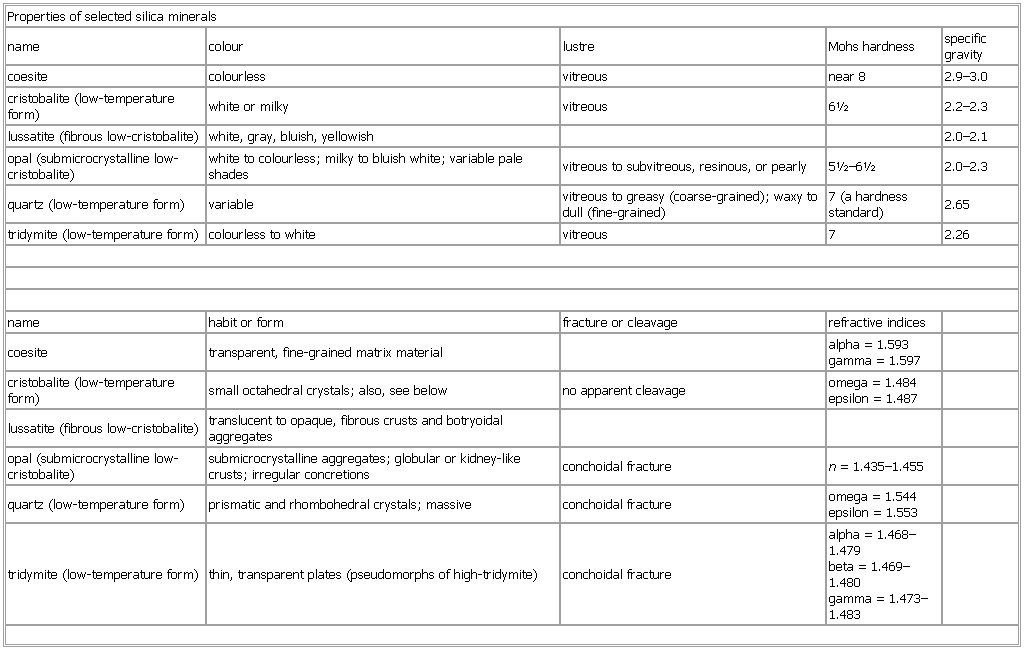Properties of selected silica minerals
- Properties of selected silica minerals
-
Properties of selected silica minerals
name colour lustre Mohs hardness specific gravity
coesite colourless vitreous near 8 2.9–3.0
cristobalite (low-temperature form) white or milky vitreous 6½ 2.2–2.3
lussatite (fibrous low-cristobalite) white, gray, bluish, yellowish 2.0–2.1
opal (submicrocrystalline low-cristobalite) white to colourless; milky to bluish white; variable pale shades vitreous to subvitreous, resinous, or pearly 5½–6½ 2.0–2.3
quartz (
low-
temperature form)
variable vitreous to greasy (
coarse-grained);
waxy to dull (
fine-grained)
7 (
a hardness standard)
2.
65
tridymite (low-temperature form) colourless to white vitreous 7 2.26
name habit or form fracture or cleavage refractive indices
coesite transparent, fine-grained matrix material alpha = 1.593
gamma = 1.597
cristobalite (low-temperature form) small octahedral crystals; also, see below no apparent cleavage omega = 1.484
epsilon = 1.487
lussatite (fibrous low-cristobalite) translucent to opaque, fibrous crusts and botryoidal aggregates
opal (submicrocrystalline low-cristobalite) submicrocrystalline aggregates; globular or kidney-like crusts; irregular concretions conchoidal fracture n = 1.435–1.455
quartz (low-temperature form) prismatic and rhombohedral crystals; massive conchoidal fracture omega = 1.544
epsilon = 1.553
tridymite (low-temperature form) thin, transparent plates (pseudomorphs of high-tridymite) conchoidal fracture alpha = 1.468–1.479
beta = 1.469–1.480
gamma = 1.473–1.483
See as table:
* * *
Universalium.
2010.
Look at other dictionaries:
tridymite — /trid euh muyt /, n. Mineral. a polymorph of quartz occurring in the form of small crystals, commonly twinned, in siliceous volcanic rocks. [1865 70; < G Tridymit, equiv. to tridym (Gk trídym(os) triple, equiv. to tri TRI + (dí)dymos DIDYMOUS) +… … Universalium
Asbestos — For other uses, see Asbestos (disambiguation). Fibrous asbestos on muscovite … Wikipedia
soil — soil1 soilless, adj. /soyl/, n. 1. the portion of the earth s surface consisting of disintegrated rock and humus. 2. a particular kind of earth: sandy soil. 3. the ground as producing vegetation or as cultivated for its crops: fertile soil. 4. a… … Universalium
Mathematics and Physical Sciences — ▪ 2003 Introduction Mathematics Mathematics in 2002 was marked by two discoveries in number theory. The first may have practical implications; the second satisfied a 150 year old curiosity. Computer scientist Manindra Agrawal of the… … Universalium
industrial glass — Introduction solid material that is normally lustrous and transparent in appearance and that shows great durability under exposure to the natural elements. These three properties lustre, transparency, and durability make glass a favoured… … Universalium
Geology of Mars — Mars Mars as seen by the Hubble Space Telescope Designations … Wikipedia
Business and Industry Review — ▪ 1999 Introduction Overview Annual Average Rates of Growth of Manufacturing Output, 1980 97, Table Pattern of Output, 1994 97, Table Index Numbers of Production, Employment, and Productivity in Manufacturing Industries, Table (For Annual… … Universalium
Cement — In the most general sense of the word, a cement is a binder, a substance which sets and hardens independently, and can bind other materials together. The name cement goes back to the Romans who used the term opus caementicium to describe masonry… … Wikipedia
Australia — /aw strayl yeuh/, n. 1. a continent SE of Asia, between the Indian and the Pacific oceans. 18,438,824; 2,948,366 sq. mi. (7,636,270 sq. km). 2. Commonwealth of, a member of the Commonwealth of Nations, consisting of the federated states and… … Universalium
Ceramic engineering — Simulation of the outside of the Space Shuttle as it heats up to over 1,500 °C (2,730 °F) during re entry into the Earth s atmosphere Ceramic engineering is the science and technology of creating objects from inorganic, non metallic… … Wikipedia

